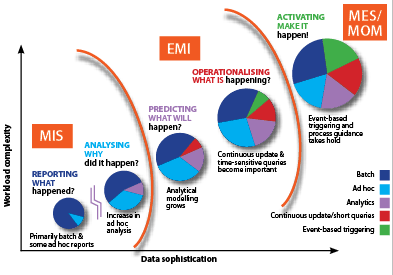

In any type of economic situation, manufacturing companies need to adapt to market conditions and make decisions that improve profitability. In an up economy, it is critical to increase throughput to keep up with demand. In a down economy, it is critical to reduce costs and to match output with demand. Management needs information to tell it how business is performing, whether it is throughput or cost reduction.
To get this information, companies implement various real-time data acquisition solutions. But how do they decide which of these solutions to implement?
Manufacturing enterprise intelligence systems (EMI), manufacturing information systems (MIS), manufacturing execution systems (MES) and manufacturing operations management (MOM) systems
Depending on the size and complexity of the company, any of these can provide the required information, but some companies may need more than one, or maybe even all of these systems.
The graphic shows not only a possible evolution of implementation, but also the typical type of information needed, so that companies may position their own requirements in order to identify what they need.

Reporting and predictability
Information needs can start where companies only use systems to provide batch-reports, typically on a daily basis. This is adequate for a lot of companies to manage their daily activities. Some occasional ad-hoc reporting may also be needed on occasion and both of these may be done using something like an historian or a database and a report writer. These tools are used to find out what happened in the previous period whilst ad-hoc reporting is used to find out why it happened. Manufacturing information systems (MIS) will be able to satisfy these needs and would be adequate for companies with simpler information needs. When a company starts to need more and more ad-hoc reporting, it indicates a need for more analysis tools.
When companies want to know what is going to happen in the immediate future, they need more sophisticated analysis tools. They will still need static reports to look at past performance, but the need for ad-hoc reporting and analysis increases to enable prediction. The processing of queries that enable this prediction are more complex and need to relate more dimensions to one another. These relationships increase the ability of management to predict how the factory is going to behave.
Prediction requires the frequent and continuous update of information and requires the display of this information using for instance historical as well as real-time information trends. Companies thus need to know what is happening at any moment in time. Not only in terms of what is happening in the factory, but also of what the markets are doing. Managers need to make decisions based on these trends and predictions. Some of these decisions may also be based on event-based triggers from the plant or the market. The information needs for companies in this situation are more time-sensitive and quick decisions are needed to change things in the factory when circumstances require it.
Enterprise manufacturing intelligence (EMI) solutions provide this real-time information and analysis needs. More complex manufacturing operations (multisite or multiplant operations for instance) require EMI solutions that enable them to manage the complexities of the factories. In a lot of cases, key performance indicators are displayed on management dashboards as well as on operator screens to ensure that everyone in the company works towards the same objectives.
These indicators are based on things that are currently happening in the plant and may make use of data from a number of disparate systems, such as automation finance and laboratory systems. This data is then related to other data using for instance dimensional models for ease of analysis. Although these systems provide decision-making information to various levels in the plant, they do not actually make things happen. They only provide information for operators and management to change, or continue, what they are doing.
Of course, when real-time process and event information become available, other solutions can be built on top of these to make use of this information. These solutions can be very diverse, such as early anomaly detection, equipment failure prediction, plant efficiency and comparative simulation and monitoring systems. These systems all require structured real-time process and event information and can add great value to any manufacturing company. They are all, however, still predictive and reporting systems in nature.
The need for action
When it becomes necessary for events to trigger certain predetermined actions, a manufacturing execution system (MES) becomes a necessity. MES solutions make things happen in a plant in a consistent manner based on prior learning and expert knowledge. MES is thus a great tool manufacturers can use to retain specific manufacturing and engineering knowledge in order to counter the loss of manufacturing and engineering skills and experience.
Triggers are used in the MES to guide operators to take the correct action when certain events take place. In some cases, these event triggers are located in disparate systems and, as such, close integration of these systems is required to ensure the relaying of time-sensitive events. The MES in turn also passes information and instructions through to other systems based on these events. These instructions or information may be in the form of set-point changes to PLCs or aggregated data to be sent to the financial system.
Most MES solutions provide batch (or time-based) reporting as well as some ad-hoc reporting functions. Analysis tools provided by typical MES solutions are mostly around specific generic MES modules and these tools do not normally provide inter-module relational reporting. They do not necessarily provide any manufacturing intelligence in the true sense of the word, but rather function-specific detailed analysis.
The bigger picture
A manufacturing operations management (MOM) solution has MES functionality at its core, but it looks wider than the historically narrow view of MES. MOM solutions provide the framework to integrate multiple operations functions into an holistic solution used to improve manufacturing operations performance. The ISA 95 series of standards define MOM activities and data exchange categories in such a way that it is easy to understand and adapt. Throughout the world, MOM is being adopted as a concept more readily than MES ever was, specifically as result of the clear definition in these standards.
Looking at the evolution in the graphic, it may seem that one would first need EMI before any MES/MOM components are implemented. Some users may say that this is putting the cart before the horse; and they would be right, but maybe only for a portion of companies. The trick is to look at the requirement (or not) for event-based triggering and the associated actions in real-time. If this is a requirement, then an MES/MOM solution is the answer, regardless of whether or not the company has an EMI solution.
Once a company has implemented MES/MOM functionality, it may also require EMI if it has the need for complex analysis and reporting and the reporting provided by the MES/MOM is inadequate to meet the requirements. In some cases, companies also use EMI solutions to relate information from different MES/MOM modules to each other, or to compare plant performance between different plants, using data from disparate underlying systems.
EMI and MES/MOM can thus either co-exist or exist independently depending on specific company needs and information requirements. As far as MIS is concerned, it can also co-exist with both of these, but in some cases the MIS may be embraced or replaced by the EMI solution.
In the final analysis, companies need to identify whether they want to report, predict or make things happen. Then they need to go out and find the solution that will meet their requirements, whether it is MIS, EMI or MES/MOM.
For more information contact Gerhard Greeff, Bytes Systems Integration, +27 (0)82 654 0290, gerhard.greef@bytes.co.za, www.bytes.co.za

© Technews Publishing (Pty) Ltd | All Rights Reserved